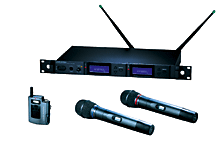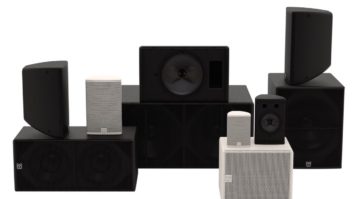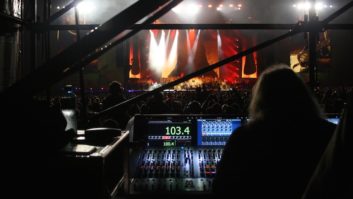
Despite anxiety over the wireless frequency crunch that’s slated for February 2009 — the date that the FCC has chosen for analog transmission to cease — the demand for wireless systems keeps growing, particularly in live sound applications.
Wireless system manufacturers continue to meet the challenge of developing more efficient and user-friendly systems, even as available frequencies become increasingly scarce. We surveyed manufacturers’ current top-of-the-line handheld units for live sound and found a wide array of systems and features, priced for any application.
AKG‘s (www.akgusa.com) WMS 4000 system operates in the 650 to 790MHz UHF range and is priced from $1,474. The WMS 4000 can access up to 1,200 channels (depending on conditions) for using more than 50 systems at once. The HT 4000 handheld comes in a choice of three dynamic and three condenser capsules. It features jog wheel control and a backlit display, showing battery life, frequency, channel/preset groups, gain setting and mute. The optional CU 4000 charging station comes with two “Smart Batteries.” The transmitter operates for 15 hours on two AA alkaline batteries or 12 hours on two AA rechargeables. The half-rack SR 4000 receiver has front-mount antennae and a backlit LCD indicating audio input, RF level, mute, frequency, group or user ID, and diversity switching, along with battery life and setup parameters. The receiver has balanced XLR and unbalanced ¼-inch outs and a data port for computer monitoring/control. An optional network hub interfaces with Harman Pro’s HiQNet system. The SR 4000 accommodates two diversity antennae; also available are a master antenna pair (directional and omni, with/without booster), an antenna splitter and multi-coupler.
Audio-Technica Artist Elite 5000 Series comprises two cardioid condenser handheld transmitters and a dual receiver.
Audio-Technica‘s (www.audio-technica.com) Artist Elite 5000 Series AEW-5255 ($3,999) includes two AEW-T5400 cardioid condenser handheld transmitters and one AEW-R5200 dual receiver with XLR output, ¼-inch TRS balanced jack and a headphone output. Another ¼-inch jack lets the user mute the system via a footswitch. The system offers 200 channels per band, available at 541.5 to 566.375 MHz, and 655.5 to 680.375 MHz. The system has two front-mounted UHF half-wave antennae and an IntelliScan feature, which automatically finds and sets the best available frequencies on all linked receivers. Its dual-compander circuitry processes high and low frequencies separately. The receiver’s onboard Ethernet interface allows monitoring and controlling system parameters with AEW Control Interface software. All transmitters have a metallic chassis, programmable features, soft-touch controls and output power switchable between 10 and 35 mW. The transmitter operates up to eight hours on two AA alkaline batteries.

Audix RAD-360 system offers 193 channels between 638 and 806 MHz.
Priced from $689 to $1,169, the Audix (www.audixusa.com) RAD-360 system offers 193 channels between 638 and 806 MHz. The half-rack RAD-360R true-diversity receiver has an optional amplified antenna distribution system, allowing up to four systems to run off a single pair of antennae. Up to 16 systems can operate simultaneously. Available with four Audix OM Series mic capsules, the RAD-360 handheld has a gain-setting control with 10/20/30dB pad to prevent overload distortion. A menu-driven LCD shows frequency selected, audio signal strength, A/B antenna indicator, mute, RF, battery indicator, audio levels and lock/unlock status. The system also offers soft-key controls for gain setting and frequency selection, noise-squelch circuitry, Surface Acoustic Wave (S.A.W.) filters and tone-key squelch. The transmitter operates up to 12 hours on two 1.5-volt AA batteries.
Avlex Corporation‘s (www.avlex.com) ACT-707 Series UHF 100 true-diversity, frequency-agile wireless systems, priced from $820 to $3,580, operate between 620 and 692 MHz with a choice of three handheld transmitters. Sixteen systems per frequency band can operate simultaneously, and the ACT-707DE receiver is available in 1, 2 or 4-channel models. Outputs are balanced XLR and unbalanced ¼-inch. Power supply is internal 90 to 264 VAC switching type. The color LCD shows the user’s name, group/channel, frequency, transmitter battery status, squelch level, RF/AF metering and PC address. An Automatic Channel-Targeting function selects the channel setting and automatically locks the receiver/transmitter to the same frequency. The system operates up to 20 hours on two AA batteries.

Azden enters the live sound market with its 511HTH.
Azden‘s (www.azdencorp.com) true-diversity 511HTH ($735) UHF handheld system comprises the 511DRH half-rack receiver and the 51HT handheld, unidirectional dynamic microphone/transmitter. The receiver has an internal antenna and operates between 793.875 and 805.875 MHz, with true-diversity operation over 63 user-selectable UHF frequencies. The system can operate for up to eight hours on two AA alkaline batteries.

Beyerdynamic Opus 800 Series includes receivers and software.
The Opus 800 Series system from Beyerdynamic (www.beyerdynamic.com) operates in four frequency ranges (740 to 764 MHz, 774 to 798 MHz, 798 to 822 MHz and 850 to 874 MHz), offering 961 preprogrammed frequencies per channel and an integrated spectrum analyzer for manual frequency selection. It includes the rackmount Opus 800 MF receiver ($719), NE 800 C receiver ($419) and Opus 800 software ($599). The receiver has a rear-mounted antenna, and its color LCD indicates frequency, group and channel, squelch, battery status, user’s name, and RF and AF level. Sixteen systems are simultaneously operable, and four handheld transmitters are available: the SDM 860 ($369), SDM 860 M ($599), SDM 869 ($369) and SEM 881 ($419). Opus 800 software allows for real-time control of a maximum of 64 channels or 64 NE 800 receiver modules. The system also offers a memory function for system settings and signal history. The transmitters can run on two 1.5V AA alkaline batteries for up to 20 hours.
The new REV system (prices start at $1,890) from Electro-Voice (www.electrovoice.com) features detachable half-wave antennae and operates with synthesized PLL-agile UHF REV-S single and REV-D dual receivers over four frequency bands — 614 to 638 MHz, 650 to 674 MHz, 674 to 698 MHz and 722 to 746 MHz. Factory-set channel groups allow 16 systems to operate simultaneously in one frequency band. More than 950 possible channels are programmable in 25kHz steps across a 24MHz operating bandwidth. The receiver’s LCD shows group, channel, diversity, label and setup. Advanced ClearScan automatic group and channel selection provide quick setup. REV offers four capsule options and two handheld body styles. REV-Link PC software enables remote monitoring, control and programming over a CAN bus connection through an E-V UCC-1 converter or E-V Netmax N8000.

Lectrosonics Venue’s Soundcheck mode finds possible dropouts.
Lectrosonics‘ (www.lectrosonics.com) Venue ($2,395 per complete channel) UT handheld transmitter and Venue modular receiver operate in UHF frequencies between 537 and 800 MHz in 25.5MHz blocks, with 256 frequencies per block; up to 70 channels are simultaneously operable. The Venue modular receiver can house up to six channels of either standard or tracking-filtered receiver modules in one rackspace, and it includes rear-mount antenna connections with DC power for RF amplifiers. The receiver shows transmitter battery level, audio level, signal strength, diversity mode and antenna phase (in switched mode). A Soundcheck mode helps determine potential dropout locations. The system’s native Digital Hybrid Wireless mode provides compander-free audio with compatible transmitters, and compatibility modes allow use with older analog transmitters. The UT handheld transmitter ($1,745) has a Vari-Mic preamp with 3-band tone control. Available condenser capsules include cardioid, supercardioid and omni patterns. The system runs on alkaline 9V batteries for four hours, and can be monitored/controlled with supplied PC software, and networked via USB and RS-232. The SNA600 folding dipole and ALP600 LPDA directional antennae are optional.

The Nady UH-1K handheld offers an internal antenna system and Nady DM-10D neodymium capsule.
Nady Systems‘ (www.nady.com) newest flagship product is the $739 UWS-1. Featuring true-diversity circuitry, it’s available in three frequency bands in the 760 to 864MHz range. The PLL-controlled system has 1,000 user-selectable channels per band. The receiver uses dual rear-mount, right-angle antennae with 9VDC phantom power for optional remote-powered antennae. IF filtering allows operating multiple UWS-1K systems in the same location. Its backlit LCD indicates the selected channel/frequency, SQL level, receiver RF level, A/B diversity status, transmitter battery level and audio LED bar graph. The UH-1K handheld has an internal antenna system and a Nady DM-10D neodymium capsule. It operates for up to 10 hours on two AA batteries.

Sabine’s SWM7000 Series includes the company’s Smart Spectrum system.
Sabine‘s (www.sabine.com) true-diversity SWM7000 Series ($1,299.99 single-channel, $2,099.99 dual-channel) operates in the 2.4 to 2.483GHz ISM band, which grants access to the same 70 preprogrammed channels simultaneously. Sabine’s Smart Spectrum system combines spread-spectrum filtering with a variation of FM technology for a more interference-resistant system with more simultaneous channels. Each system includes FBX Feedback Exterminator, parametric filters, Mic SuperModeling, a compressor/limiter and adaptive de-esser. The rackmount SW2-NDR receiver has two rear-mounted coaxial dipole antennae. SW70 Series handhelds use Audix OM3 or OM5 dynamic capsules or a Voice Technologies condenser. Accessories include rackmount antenna distribution for up to six receivers and a low-profile extension antenna for unobtrusive wall-mounting. Transmitter functions can be controlled from the receiver, the included Windows remote-control software, from Crestron or AMX touchscreens or any serial-based controllers. Sabine rechargeable batteries offer nine hours per charge, or the transmitter can operate for 15 hours on two AA alkaline cells.
The UHF Synth Series Six from Samson Technologies (www.samsontech.com) uses two independent, synthesized receivers ($2,199.99) in one rackspace and works with a variety of popular handheld mics, offering 101 channels in two frequency spectrums — 782.125 to 793.875 MHz and 794.125 to 807.875 MHz. A spectrum-analyzer feature scans for the clearest available frequencies, and up to 96 systems can operate simultaneously at 1mW power or up to 22 systems at 10mW power. The receiver has balanced XLR and unbalanced ¼-inch outs, and its backlit LCD shows channel and frequency selection, mute, tone, squelch, receiver ID and more. Its power supply senses voltages automatically. Transmitters ($609.99) are powered by AA batteries. The system can be controlled remotely with a PC using Samson’s WSM (Wireless System Manager) software.
Sennheiser (www.sennheiserusa.com) followed up its SKM 5000 with the SKM 5200-UHF ($2,115). The new transmitter features 7,200 frequencies, a menu-driven user interface in a backlit LCD, three selectable low-cut filters and mic sensitivity adjustable in 1dB steps. The transmitter’s LCD indicates battery-charge status, which is also transmitted to suitable receivers. The SKM 5200 offers a fixed channel bank and a variable bank. The fixed bank can be ordered with 20 preset frequencies to allow the transmitter to be integrated quickly into existing RF environments. Users can program up to 20 UHF frequencies in 5kHz steps into the variable bank. The system is compatible with five condensers and one dynamic handheld — as well as Neumann’s KK 105 and KK 104 capsules — with omnidirectional, cardioid, wide-cardioid or supercardioid pickup patterns. Its HiDyn Plusnoise reduction system keeps RF noise to a minimum. The SKM 5200 offers more than eight hours of operation using the rechargeable battery pack or standard alkaline batteries.
Prices for Shure‘s (www.shure.com) UHF-R system begin at $3,043 for a single-channel system with an SM58-equipped transmitter. The system offers 2,400 selectable frequencies and allows up to 40 preset-compatible systems to be operated per band. Up to 108 systems are operable simultaneously using multiple bands. Shure’s Advanced Track Tuning Filtering technology shifts onboard RF filtering within selected frequencies to maximize compatibility and isolation from interference. The UR2 handheld transmitters are offered with SM58, SM86, SM87, Beta 58, Beta 87A and Beta 87C capsules, and feature automatic frequency selection with group scan, infrared automatic transmitter sync and menu-driven system operation. UHF-R receivers have Flash memory capable of storing six 60-channel custom-frequency groups. They’re also compatible with AMX and Crestron touchscreens and facilitate USB and Ethernet network control and monitoring. Accessories include an antenna/power distribution system, passive antenna splitter kit and active or passive directional wideband antennae. UHF-R systems ship with Wireless Workbench software, providing PC management of system parameters, plus a real-time view of the complete, networked environment.
Sony‘s (www.sony.com/professional) Legacy 800 Series includes the single-rackspace MB-8N tuner base ($2,750), WRU-8N UHF synthesized tuner unit ($1,000 each), WRT-8B UHF bodypack transmitter ($1,850) and WRT-847 transmitter ($1,000), which works with five capsules priced from $445 to $550 each. The transmitter operates on two AA alkaline batteries for eight hours of operation. Its LCD shows channel number, frequency, audio input status, RF level output/status, attenuator level, remaining battery power and more. Audio outputs are XLR. This system has a 116dB dynamic range and 20 to 20k Hz response, and can be controlled from any Ethernet-equipped PC via included software. WRU-8N tuners include LED AF/RF level and transmitter battery alarm indicators, as well as an LCD for viewing channel, frequency and group settings. Up to four WRU-8Ns can be installed in one MB-8N base, and up to four MB-8Ns can be linked for a total of 16 channels, without requiring an antenna divider.
TOA Electronics (www.toaelectronics.com) recently expanded its lineup with the 5000 Series system, which operates in the 692 to 722MHz band. Up to 16 systems can be operated at once. The WM-5220 ($292) handheld condenser is powered by a single AA battery for 10 hours of operation. Receiver models include the WT-5800 ($628) true-diversity 64-channel wireless tuner, WT-5805 ($482) space-diversity 64-channel wireless tuner and the portable WT-5810 ($384) space-diversity 16-channel wireless tuner. All 5000 Series receivers feature a frequency-scanning function and transmitter battery-status indicator.
Zaxcom‘s (www.zaxcom.com) digital wireless system ($1,850) includes its handheld digital wireless microphone. The system operates between 536 and 850 MHz in 25MHz frequency blocks. It can run for approximately four hours powered by two AA lithium ion batteries. The handheld microphone system is encrypted and completely digital (no companding), with digital modulation and audio quality equivalent to a hardwired microphone. The company’s handheld can be used with any standard wireless screw-on Shure capsule.
Matt Gallagher is an assistant editor at Mix.





